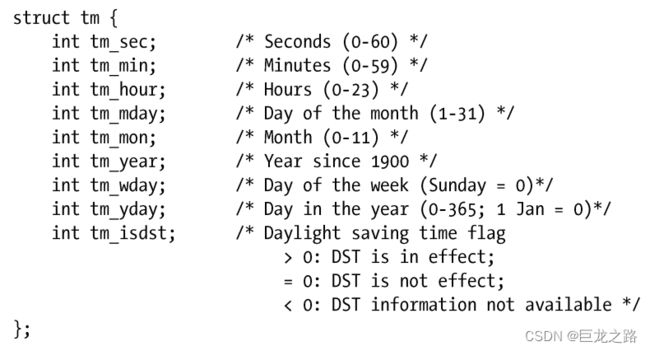Linux的时间函数
2023年7月19日,周三下午
我今天基于GitHub搭建了自己的博客网站,欢迎大家来我的个人博客网站阅读我的博客
巨龙之路的GitHub个人博客 (julongzhilu.github.io)
目录
- time
- 函数原型
- 使用方法
- ctime
- 函数原型
- 使用方法
- 疑惑
- gmtime、 localtime
- 函数原型
- 什么是分解时间
- 使用方法
- mktime
- 函数原型
- 使用方法
- asctime
- 函数原型
- 使用方法
time
函数原型
获取自 1970 年 1月 1 日早晨零点到现在的秒数,也叫做
#include
time_t time(time_t *timep); 使用方法
如果time函数的参数timep为NULL,那么time函数会返回自 1970 年 1月 1 日早晨零点到现在的秒数;
#include
#include
int main(){
time_t tm;
tm=time(NULL);
printf("%d",tm);
} 如果time函数的参数不为NULL,那么time函数会把自 1970 年 1月 1 日早晨零点到现在的秒数赋值给timep指向的time_t类型变量
#include
#include
int main(){
time_t tm;
time(&tm);
printf("%d",tm);
} 建议使用time(NULL),因为这样可以减少出错的可能性,并且使用起来更简单
ctime
函数原型
将time_t转换成可打印格式,所谓可打印格式类似于“Wed Jul 19 01:59:16 2023”
#include
char *ctime(const time_t *timep); 使用方法
把一个指向 time_t 的指针作为 timep 参数传入函数 ctime(),将返回一个长达 26 字节的字符串,内含标准格式的日期和时间
#include
#include
int main() {
time_t current_time;
time(¤t_time);
char* time_str = ctime(¤t_time);
printf("Current time: %s", time_str);
return 0;
} 疑惑
为什么ctime函数要用一个指针作为参数,这样不是很麻烦吗?
这是因为ctime函数需要修改一个静态缓冲区中的内容,并返回指向该缓冲区的指针。这个缓冲区包含了一个字符串表示的时间。通过将时间的指针传递给ctime函数,函数可以直接在缓冲区中进行修改,然后返回指向缓冲区的指针,以便用户可以使用这个字符串。
也就是说,通过用指针作为参数,ctime函数就不需要拷贝一份time_t,再根据这副本来修改静态缓冲区的内容,而是可以直接通过指针找到time_t来修改静态缓冲区的内容。这样可以节省内存空间和提高运行效率。
需要注意的是,ctime函数在每次调用时都会使用同一个静态缓冲区,因此如果多次调用ctime函数,后续的调用会覆盖前面调用的结果。如果需要保存多个时间字符串,可以使用localtime或gmtime函数进行转换,并使用不同的缓冲区来存储结果。
gmtime、 localtime
函数原型
#include
struct tm *gmtime(const time_t *timep);
struct tm *localtime(const time_t *timep); 什么是分解时间
所谓分解时间,其实就是把time_t分解成年、月、日、时、分,秒等
使用方法
#include
int main(){
time_t ti;
struct tm *gm_tm;
struct tm *local_tm;
//把从1970年1月1日00:00到现在的秒数赋值给ti
ti=time(NULL);
//用gmtime函数把ti分解成年、月、日、时、分、秒等,并把分解的结果
//存放在一个静态分配的结构tm中,返回tm的地址给gm_tm
gm_tm=gmtime(&ti);
//用localtime函数把ti分解成年、月、日、时、分、秒等并把分解的结果
//存放在一个静态分配的结构tm中,返回tm的地址给local_tm
local_tm=localtime(&ti);
printf("gm_tm:%d-%d-%d %d:%d:%d\n",gm_tm->tm_year+1900,gm_tm->tm_mon+1,gm_tm->tm_mday,gm_tm->tm_hour,gm_tm->tm_min,gm_tm->tm_sec);
printf("local_tm:%d-%d-%d %d:%d:%d\n",local_tm->tm_year+1900,local_tm->tm_mon+1,local_tm->tm_mday,local_tm->tm_hour,local_tm->tm_min,local_tm->tm_sec);
} mktime
函数原型
mktime函数将一个分解时间转换成time_t值
#include
time_t mktime(struct tm *timeptr); 使用方法
#include
#include
int main(){
//获取当前时间的time_t值
time_t current_time;
current_time=time(NULL);
printf("1:current_time:%d\n",current_time);
//把当前时间的time_t值转换成分解时间
struct tm *current_tm;
current_tm=gmtime(¤t_time);
//把分解时间再转换成time_t
current_time=mktime(current_tm);
printf("2:current_time:%d\n",current_time);
} asctime
函数原型
asctime函数把分解时间转换成可打印格式,所谓可打印格式类似于“Wed Jul 19 01:59:16 2023”
#include
char *asctime(const struct *timeptr);
使用方法
#include
#include
int main(){
time_t current_time;
current_time=time(NULL);
//获取分解时间
struct tm *current_tm;
current_tm=gmtime(¤t_time);
//把分解时间转换成可打印格式
char* printFormat;
printFormat=asctime(current_tm);
printf("%s",printFormat);
} 


